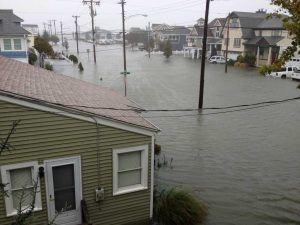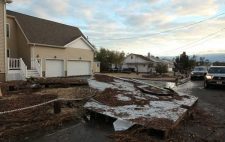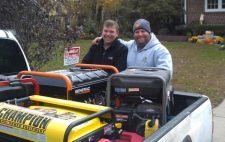As a TV meteorologist, Kathy Orr first knew Hurricane Sandy would be bad about five days before it hit. That’s when all the computer forecasting models at CBS3 began to agree on one thing: Mother Nature had put what amounted to a bull’s-eye on the SJ shore line.
“This was our Katrina at the Jersey Shore,” Orr says.
Orr is no stranger to reporting on the big weather stories in the SJ and Greater Philadelphia area. The Emmy-award winner first appeared to local audiences in 1998 as the first female meteorologist in the region. She’s been reporting for CBS3’s “Eyewitness News” for the last 10 years. The Burlington County resident had forecast blizzards and hurricanes before. She’s even broadcast live from inside of the cockpit of an airplane during a hurricane in 2004.
But Orr says nothing else compares to Hurricane Sandy.

Kathy Orr tweeted this photo of flooding along the north end of Ocean City
“This was the Jersey Shore’s worst case scenario…taking a direct hit, and at high tide. This will be the storm that every other storm will be compared to,” Orr says. “There has never before been a hurricane that made a direct landfall” perpendicular to the SJ shoreline. “It was unprecedented because it was a Category 1 hurricane late in the season. The Jet Stream was very active and captured that storm. That had never happened before.”
The broadcast team at CBS3 had a week to prepare for the on-air marathon of storm coverage. Orr says she, her producers and fellow meteorologists – including Carol Erickson, Justin Drabick, Kate Bilo and Katie Fehlinger – would send updates to producers and management about the storm’s progress. It was all hands on deck to get extra crews in to work the storm coverage the weekend before it hit.
“We don’t do that for every storm,” Orr explains, because the computer models are not always reliable. But she says it soon became clear that Sandy would happen and become a full-blown storm.
“I brought everything with me – my suitcase – to stay the night if I had to,” Orr says.
Orr and the rest of the news crew clocked 80 hours of storm coverage; almost 20 on the day after the storm. A veteran of many storm broadcasts, Orr says she didn’t worry much about her family riding out the storm.
“We were prepared to be without power for at least a week. We were lucky. We only lost power intermittently during the storm, but we were okay afterward. But half of our town was without power for about a week.”
She says her real worry was for the people being bombarded along the SJ coastline.
“The people I’ve reported on down at the shore. The landmarks, the beaches, the memories, that was my real concern,” Orr recalls. “I became very worried Monday when the first high tide breached LBI at Beach Haven. And part of Ocean City was breached, but there were still two more high tides.

Meteorologists Kate Bilo and Kathy Orr snack before going on air
“We talked on the air about people being without power and the property damage. We didn’t want to freak anybody out, but when that happened, it was like, ‘oh boy, this is the real thing.’ That’s when I actually started to feel afraid.”
Orr says that while SJ’s shore towns were literally in the eye of the storm – making landfall just south of Atlantic City – that direct hit may have been the very thing that spared SJ towns from the worst damage.
“The towns north of the landfall got it worst. Nothing beats Seaside Heights. If the storm had hit farther south, the damage we saw in Seaside Heights would have hit much closer to home. We should feel fortunate. We could have been so much more vulnerable.”
Even at the height of the storm, Orr still had a job to do. And not just on TV. With thousands all over the area losing power, social media on cell phones was often the only source of crucial information.
“I was tweeting constantly – pictures and information and wind gusts,” says Orr, who tweets at @KathyOrrCBS3. “It became an important component of our coverage. It was the only way to get the word out to people, and a way for people to stay connected to the world. It was an intense, constant thing that really helped some people, especially when people were cut off from power and sitting in the dark.”
In addition to TV and Twitter, the meteorological team was also constantly blogging, giving live radio updates to all of the CBS radio networks stations in the area. They were even being interviewed by other news reporters from as far away as California. “It wasn’t just about being on TV anymore,” Orr says.
To keep focused during the nearly 48-hour broadcast, Orr says it can be a challenge to manage the fatigue. “You run on adrenaline and have to pace yourself. We were working so hard to get it right.”
Orr says some (mostly) healthy snacking also helps keep up their energy. The day before the storm made landfall, she Tweeted a picture captioned “The weather team storm stash,” including bananas, cereal and breakfast bars, popcorn, peanut butter and jelly sandwich fixings, and a bag of M&Ms.
Even after the news team finally signed off, Orr says all the meteorologists stayed in the newsroom into the early hours Wednesday morning. “It’s like you’re almost too tired to go to bed.”
If there is any good to come out of the Hurricane Sandy aftermath, Orr says it is that new attention is being paid to “the reality of climate change.”
“I believe that the climate is changing,” Orr says. “The ocean levels are warming. The sea level is rising. Regardless of whether you believe it’s because of human causes or natural causes, the climate is changing. There is a warming of the earth. Storms are maintaining hurricane status so far north, so late in the season; that’s a sign of a warming world.”
Orr says Hurricane Sandy will now be the benchmark for all future hurricanes at the Jersey shore. The meteorologist and her producers are already looking ahead to next summer, when Orr fully intends to continue her popular “Orr at the Shore” segments.
“I do hope Sandy is a once in a lifetime storm,” Orr says. “Our precious shore will rise again. But we also must take these warnings seriously.”














